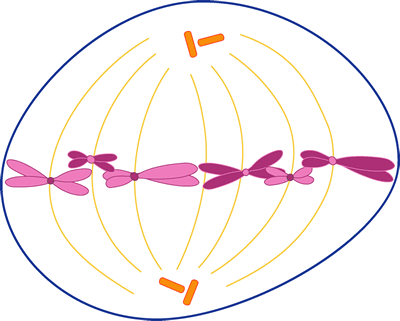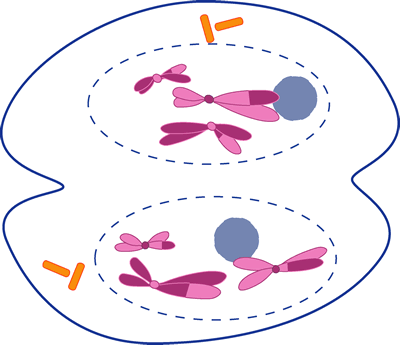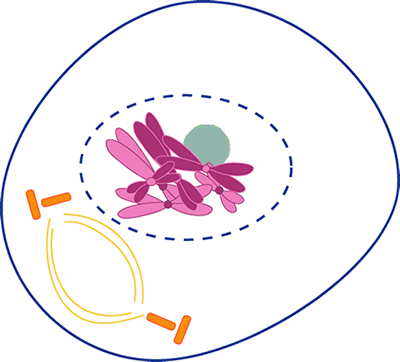Epigenome
IDENTICAL TWINS: PINPOINTING ENVIRONMENTAL IMPACT ON THE
EPIGENOME
1. Often, the physical characteristics of genetically identical twins become increasingly
different as they age, even at the molecular level. Explain why this is so. (use the
terms "environment" and "epigenome")
1A. Differences in identical twins accumulate throughout time due to the environment. Identical twin epigenomes start out the same since they share the same environment, but as they age and time goes on, their environments start to differentiate. Different environmental factors add or remove epigenetic tags which alter the epigenome and influence the twins. One twin will have a certain gene silenced that another does not.
2. Name 3-4 environmental factors that influence the epigenome.
2A. Diet, physical activity, stress, and toxin exposure can alter the epigenome.
3. What is an imprinted gene?
3A. An imprinted gene is a gene that comes from a parent chromosome and contains epigenetic tags that did not get erased.
YOUR ENVIRONMENT, YOUR EPIGENOME
1. Discuss factors in your daily life (ie. Diet, exercise, stress etc.) that could be affecting
your epigenome
1A. The type of foods I eat, amount of exercise I do, and the level of stress I have can affect my epigenome.
LICK YOUR RATS
1. Explain how a high-nurturing mother rat shapes her pup's epigenome, and what that
pup's response to stress will be.
1A. A high-nurturing mother rat will shape her pup's epigenome by constantly licking, nursing, and grooming its pup. The pup will then react calmly to stress, where a poorly nurtured pup will be very nervous and intimidated by stress.
2. In rats, does licking by the mother activate, or deactivate her pup's GR gene?
2A. Licking by the mother activates a pup's GR gene.
3. Explain how cortisol and the GR protein work together in the brain to relax a rat pup.
You may draw a diagram.
3A. In the hippo campus, the part of the brain that controls stress, cells will produce Glucocorticoid Receptor protein amounts that vary depending on how well it is nurtured. During fight or flight cortisol, a hormone, is produced in the hippo campus, it will bind to the GR protein and send out signals that tell the rat to be calm. Rats with a lot of GR will have a lot more signals telling it to calm down and they will not be as stressed as a rat with very few GR proteins and very few calm signals.
4. The rat nurturing example shows us how parental behavior can shape the behavior of
their offspring on a biochemical level. Relate this to humans and think about the personal
and social implications. Record your thoughts.
4A. I think that the basic idea of the rule of high-nurturing and low-nurturing for rats applies to humans. If a child is brought up by negligent parents, it will be less secure and happy than a child that was brought up by loving parents.
NUTRITION & THE EPIGENOME
1. Explain how the food we eat affects gene expression.
1A. The food we eat affects our gene expression by determining how we look. The food you eat contains nutrients that are removed and put into metabolic pathways. They are them shaped into molecules that are used in the body. One pathway is used to create methyl groups. When you eat food that contains good amounts of methyl, you are more fit than someone who eats food with very little methyl.
2. Can the diets of parents affect their offspring's epigenome?
2A. Yes, when a woman is pregnant, her diet is very important. She needs to intake foods that have plenty of methyl. She also needs to cut back on fatty foods and eat healthy. These choices affect the child by making it healthy (but all that can change by the choices it makes in its life). The father's father's diet is important because the amount of food he was able to have can allow a grandchild to live long and prosper, or have a short life. Studies show that grandfathers who had less to eat actually had extended life compared to those with an abundance of food, thus grandchildren of these people will encounter the same effects the grandfathers received.
EPIGENETICS & THE HUMAN BRAIN
1. How does Dietary methyl influence gene expression?
1A. Dietary methyl influences gene expression because the amount of methyl you retain from nutrients in your food keep you healthy. If you have a methyl-deficient diet you are prone to obesity.
2. Why do Toxins affect gene methylation?
2A. Toxins affect gene methylation by damaging your health. For example, the chemical BPA can cause endocrine problems like obesity, stunted growth, and birth defects.



 This is metaphase because the chromosomes are all aligned.
This is metaphase because the chromosomes are all aligned. This stage is Cytokinesis because the daughter cells are being cleaved.
This stage is Cytokinesis because the daughter cells are being cleaved. This stage is Prophase because the mitotic spindles are forming.
This stage is Prophase because the mitotic spindles are forming.